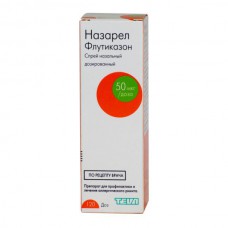Expiration date: 12/2025
The composition and form of issue:
nasal spray dosed, 1 dose contains active substance:
fluticasone propionate 50 mcg
auxiliary substances: Polysorbate 80 is 0.005 mg MCC + carmellose sodium (dispersive cellulose) at 1.55 mg of dextrose, 5 mg benzalkonium chloride (50% solution) — 0,04 mg phenylethanol — 0.25 mg water — sufficient quantity
for 60, 120 or 150 doses in dark glass bottles (type 1) with a metering device and a protective cap in the paper cartons 1 a bottle.
Description pharmaceutical form:
White or almost white, opaque, homogeneous suspension.
Pharmacokinetics:
Absorption
After intranasal fluticasone (200 mcg/day) Cmax in plasma in most patients below the level of detection (<0.01 ng/ml). Direct absorption from the mucous membrane of the nasal cavity is extremely small due to the low solubility of the drug in water owing to this, most of the dose is swallowed. From the gastrointestinal tract, the blood receives less than 1% of the dose due to low absorption and first-pass metabolism. These reasons are due to the extremely low cumulative absorption of the drug from the mucous membrane of the nasal cavity and the gastrointestinal tract.
Distribution
Fluticasone in stable condition and has significant Vd — about 318 l. the plasma protein Binding is 91%.
Metabolism
Has the first pass effect through the liver. Metabolized in the liver with participation of isoenzyme CYP3A4 of cytochrome P450 with the formation of active carboxyl metabolite.
Excretion
T1/2 is 3 h. write mainly through the intestines. The renal clearance of fluticasone is less than 0.2%, the renal clearance of the metabolite containing carboxyl group is less than 5%.
Description pharmacological action:
Corticosteroids for local use. In recommended doses, has expressed antiinflammatory, decongestant and antiallergic action. Anti-inflammatory effect is realized in the result of the interaction of the drug with the receptor GCS. Suppresses proliferatiou fat cells, eosinophils, lymphocytes, macrophages, neutrophils, reduces production and release of inflammatory mediators and other biologically active substances (including histamine, PG, LT, cytokines) during the early and late phase allergic reactions. Anti-allergic effect is manifested through 2-4 hours after the first application. Reduce itchy nose, sneezing, runny nose, nasal congestion, unpleasant feelings in area of the paranasal sinuses and sense of pressure around the nose and eyes. Relieves eye symptoms associated with allergic rhinitis. The effect of the drug lasts for 24 hours after a single application. When used in therapeutic doses, fluticasone does not show systemic action and practically no effect on hypothalamic-pituitary-adrenal system.
Indications:
Prevention and treatment of seasonal and perennial allergic rhinitis.
Contraindications:
- hypersensitivity to fluticasone and other components of the drug
- children up to age 4 years.
Caution: if it is accompanied by the herpes simplex, and bacterial infections of the upper respiratory tract. In such cases, you should also prescribe antibiotics and/or antivirals after surgery in the nasal cavity or trauma to the nose, and in the presence of ulcerative lesions of the nasal mucosa in conjunction with other dosage forms of corticosteroids including tablets, creams, ointments, remedies for the treatment of bronchial asthma, similar nasal sprays or eye and nasal drops.
Application of pregnancy and breast-feeding:
Not recommended to appoint in pregnancy. If necessary, you should consider the expected benefit of therapy for the mother and the potential risk to the fetus.
The penetration of fluticasone in breast milk is unlikely. However, the drug breastfeeding should stop.
Side effects:
A local reaction. Often observed headaches, dryness and irritation of nose and throat, unpleasant taste and smell, burning sensation, nasal congestion, nose bleed very rare — perforation of the nasal septum (usually in patients who had previously undergone surgical intervention in the nasal cavity).
Allergic reactions. Possible skin rash, very rarely — anaphylactic reactions and bronchospasm, angioneurotic edema (mostly swelling of the face, oral cavity and pharynx).
Long-term use in high doses, concomitant or previous use of corticosteroids for systemic effects in rare cases, there is decrease in the function of the adrenal cortex, osteoporosis, growth retardation in children, cataracts, increased intraocular pressure.
Drug interactions:
Interaction with other drugs is unlikely because in intra way of introduction, the concentration of fluticasone in plasma is very low. While the use of strong inhibitors of the CYP3A4 isoenzyme of cytochrome P450 (ritonavir) may increase the systemic effects of fluticasone and the development of side effects (Cushing's syndrome, inhibition of the function of the adrenal cortex). While the use of other inhibitors of cytochrome P450 (erythromycin, ketoconazole) has been a slight increase blood levels of fluticasone that does not affect the cortisol.
Method of application and dose:
The intranasal route.
Adults and children 12 years and older: 2 doses (100 mcg) in each nasal passage 1 time per day, preferably in the morning. In some cases you must enter 2 doses in each nostril 2 times a day (maximum daily dose 400 mcg). After a therapeutic effect you can enter a maintenance dose of 50 mg/day in each nostril (100 mcg). The maximum daily dose should not exceed 400 µg (4 doses in each nostril).
Elderly patients no dose adjustment is required.
Children aged 4 to 12 years: one dose (50 mg) 1 times a day in each nostril, preferably in the morning. The maximum daily dose should not exceed 200 micrograms in each nostril. It is necessary to use the minimum dosage that provides effective elimination of symptoms. To achieve the full therapeutic effect of the drug should be used regularly.
Instructions for use
Bottle with nasal spray fitted with a protective cap that protects the ferrule from dust and pollution.
The first application you need to prepare the bottle: press the dispenser 6 times. The spray mechanism razblokirovat. If you have not used the drug for more than a week, you should re-prepare the bottle and unlock the spraying mechanism.
Next, you need to:
- to unclog the nose
- close one nostril and enter the tip into the other nostril
- tilt the head slightly forward, continuing to hold the spray bottle vertically
- start doing breath through your nose, continuing to inhale, to produce a single press of fingers on the dispenser to spray
- exhale through the mouth.
Further, in the same way to introduce the drug in the other nostril. After use, wet the tip with a clean tissue or handkerchief and close it with the cap. The sprayer should be washed at least 1 time a week. It is necessary to remove the tip, rinse it in warm water, dry and then carefully set the top of the bottle. To wear the protective cap. If the hole of the handpiece is clogged, the tip should be removed and left for some time in warm water. Then rinse under the tap, dry it and then put on the bottle. It is impossible to clean the hole with a pin or other sharp objects.
Use for not more than 3 months after the first application of spray.
Overdose:
Symptoms of acute and chronic overdoses are not registered. When administered intranasally to volunteers 2 mg fluticasone 2 times daily for 7 days did not detected any influence on the hypothalamic-pituitary-adrenal system.
Special instructions:
The combined use of inhibitors of the isoenzyme CYP3A4 of cytochrome P450 (ritonavir, ketoconazole) requires careful monitoring of the condition of the patients, as these drugs can cause increased concentrations of fluticasone in plasma.
Perhaps the appearance of systemic effects of nasal corticosteroids, especially if they are appointed for a long period of time and in large doses. Therefore, long-term use of the drug requires regular monitoring functions of the adrenal cortex. As nasal corticosteroids even when used in permitted doses can cause a slowing of growth in children during prolonged therapy should regularly monitor the growth of the child and to adjust the dose.
In the treatment of seasonal allergic rhinitis Nasarel quite effective, however, in the case of especially high concentrations of allergens in the air in the summer may require additional treatment.
Nazarel
(Fluticasone)
50mcg/dose
120
doses
nasal
spray
- Brand: Teva

- Availability:
in stock
Categories:
-
$10.00

